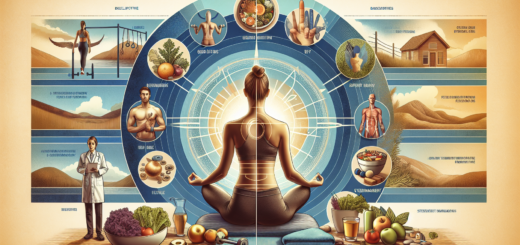Understanding the Distinction: Skill and Health Related Fitness
Are you curious about the difference between skill and health related fitness? It’s a distinction that often goes overlooked, but understanding it can have a significant impact on your overall fitness journey. Skill related fitness refers to your ability to perform specific tasks or activities, such as agility, balance, and coordination. On the other hand, health related fitness focuses on your overall physical well-being, including cardiorespiratory endurance, muscular strength, and flexibility. By recognizing the differences between these two types of fitness, you can tailor your workouts to meet your goals more effectively.
Understanding the Distinction: Skill and Health Related Fitness
In the realm of fitness and wellness, it is important to understand the distinction between skill and health related fitness. While both play a vital role in maintaining a healthy and active lifestyle, they differ in their focus and components. By understanding the nuances of skill and health related fitness, you can better tailor your exercise routine and keep your body in optimal condition.
Defining Skill and Health Related Fitness
Skill related fitness refers to the specific abilities and qualities that enable an individual to excel in sports or specific physical activities. These skills include agility, coordination, balance, power, speed, and reaction time. Essentially, skill related fitness is about honing the attributes that make you proficient in a particular activity or sport.
On the other hand, health related fitness encompasses the overall physiological well-being of an individual. It includes components such as cardiovascular endurance, muscular strength, muscular endurance, flexibility, and body composition. Health related fitness focuses on fostering a healthy body and mind, improving overall physical function, and reducing the risk of chronic diseases.
Components of Skill and Health Related Fitness
To delve deeper into skill and health related fitness, it is important to examine their individual components. Skill related fitness includes agility, which is the ability to quickly change direction or position with precision. Coordination involves using multiple body parts smoothly and efficiently. Balance refers to the ability to maintain equilibrium, while power is the combination of strength and speed. Speed, as the name suggests, relates to the quickness of movement, and reaction time is the ability to respond swiftly to a stimulus.
In contrast, health related fitness consists of cardiovascular endurance, which refers to the ability of the heart and lungs to supply oxygen to the muscles during sustained physical activity. Muscular strength is the maximum force a muscle group can generate, while muscular endurance is the ability to perform repetitive movements without fatigue. Flexibility is the range of motion around a joint, and body composition refers to the proportion of fat, muscle, and bone in the body.
Importance of Skill and Health Related Fitness
Both skill and health related fitness are crucial for leading a well-rounded and fulfilling life. Skill related fitness enables individuals to excel in specific activities and sports, improving performance and increasing the enjoyment derived from these activities. It allows individuals to showcase their talent, compete at higher levels, and achieve their personal goals.
Health related fitness, on the other hand, is essential for overall well-being and longevity. Regular exercise and maintenance of health related fitness components can reduce the risk of chronic diseases such as heart disease, diabetes, and certain types of cancer. It also plays a crucial role in maintaining healthy body weight, managing stress, and enhancing mental well-being.
Development and Training of Skill and Health Related Fitness
To develop and train skill related fitness, it is essential to focus on activities and exercises that target the specific components mentioned earlier. This could include practicing agility drills, improving coordination through balance exercises, performing power-based movements, engaging in speed training, and incorporating reaction time drills into your routine. Consistency and progressive overload are key in improving skill related fitness.
For health related fitness, incorporating a combination of cardiovascular exercises, strength training, flexibility exercises, and proper nutrition is crucial. Aerobic exercises such as running, swimming, or cycling improve cardiovascular endurance. Strength training exercises like weightlifting help increase muscular strength and endurance. Flexibility exercises, such as yoga or stretching routines, enhance joint range of motion. A well-rounded and balanced approach to training is necessary for optimal health related fitness development.
Assessing Skill and Health Related Fitness
To gauge skill related fitness, various tests and assessments can be conducted. These tests evaluate agility, coordination, balance, power, speed, and reaction time. Examples of skill related fitness assessments include the Illinois Agility Test, the Balance Beam Test, and the Vertical Jump Test. These assessments can provide valuable insights into an individual’s skill levels, allowing for targeted training and improvement.
In terms of health related fitness, assessments focus on evaluating cardiovascular endurance, muscular strength, muscular endurance, flexibility, and body composition. Common tests include the 1-mile run, push-up test, sit-up test, sit and reach test, and body composition analysis. These assessments provide a baseline measurement of an individual’s health related fitness and can be used to track progress over time.
Common Misconceptions about Skill and Health Related Fitness
There are some common misconceptions surrounding skill and health related fitness. Firstly, skill related fitness is often mistaken for overall fitness, when in fact, it is just one aspect of fitness. Health related fitness encompasses a broader range of components and is essential for maintaining long-term health and well-being.
Another misconception is that skill related fitness is only relevant for athletes or those participating in sports. While skill related fitness is indeed crucial for sports performance, it is also beneficial for everyday activities. Improving agility, coordination, and balance can enhance overall movement efficiency and reduce the risk of injuries in daily tasks.
Overlapping Elements of Skill and Health Related Fitness
Although skill and health related fitness have distinct components, there are overlapping elements between the two. For instance, cardiovascular endurance is essential for both skill related and health related fitness. It allows athletes to sustain high-intensity activities for longer periods, while also promoting heart health and efficient oxygen delivery to the body.
Similarly, flexibility plays a role in both skill and health related fitness. In sports, increased flexibility can enhance performance and reduce the risk of muscle strains. In everyday life, good flexibility promotes proper posture, eases joint movement, and reduces the risk of injuries.
Benefits of Enhancing Skill and Health Related Fitness
Enhancing both skill and health related fitness offers numerous benefits. By improving skill related fitness, you can enhance performance in specific sports or activities, allowing you to surpass previous limits and achieve personal goals. This boost in skill can enhance confidence and self-esteem, as well as foster a sense of accomplishment.
Improving health related fitness has far-reaching benefits. It can reduce the risk of chronic diseases and enhance overall longevity. It also helps individuals maintain a healthy body weight, increase energy levels, improve sleep quality, strengthen the immune system, and boost mental well-being.
Application of Skill and Health Related Fitness in Various Activities
Both skill and health related fitness have widespread applications in various activities. Skill related fitness is crucial for sports such as basketball, soccer, tennis, and gymnastics, where agility, coordination, and power play significant roles. It is also beneficial for activities such as dancing, martial arts, and rock climbing.
Health related fitness, on the other hand, applies to all aspects of life. Whether it’s maintaining cardiovascular endurance for a hike in the mountains, building muscular strength for carrying groceries, or improving flexibility for daily stretching routines, health related fitness is relevant and applicable to everyday activities.
Tips for Improving Skill and Health Related Fitness
To improve skill related fitness, consider engaging in sport-specific training and drills that target the individual components. Seek guidance from coaches or trainers who can design appropriate training programs to enhance agility, coordination, power, speed, and reaction time. Consistency and persistence are key in developing skill related fitness.
For health related fitness improvement, aim for a well-rounded exercise routine that includes both cardiovascular exercises and strength training. Incorporate activities that improve flexibility and body composition as well. Additionally, maintaining a balanced and nutritious diet is crucial for optimizing health related fitness.
In conclusion, understanding the distinction between skill and health related fitness is essential for tailoring an effective exercise regimen. Both skill and health related fitness play vital roles in leading a healthy and active lifestyle. By focusing on the components of each, assessing current fitness levels, debunking common misconceptions, and improving overall fitness through targeted training and good nutrition, you can optimize your well-being and enjoy the benefits of a balanced fitness routine.















It's great that you talked about how business insurance can provide financial protection against unexpected events and help ensure the…
I like that you mentioned how business insurance is essential for protecting your bottom line and the long-term viability of…